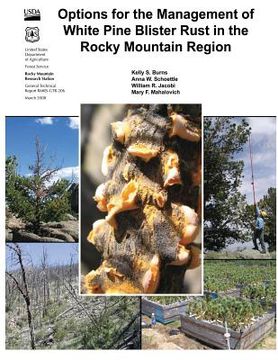Options for the Management of White Pine Blister Rust in the Rocky Mountain Region (en Inglés)
Reseña del libro "Options for the Management of White Pine Blister Rust in the Rocky Mountain Region (en Inglés)"
White pine blister rust (WPBR) is an exotic, invasive fungal disease of white, stone, and foxtail pines (also referred to as white pines or five-needle pines) in the genus Pinus and subgenus Strobus (Price and others 1998). The disease, which is native to Asia, was accidentally introduced separately into eastern and western North America at the beginning of the 20th century. In the West, WPBR was introduced on infected eastern white pine (Pinus strobus) nursery stock shipped to Vancouver, B.C., from France in 1910. Since then, the disease has spread into the distributions of most western white pines. Although all of the North American white pine species are susceptible to WPBR (Bingham 1972, Hoff and others 1980), it was once thought that the remote, dry habitats occupied by the noncommercial, high elevation white pines would not support rust establishment. Unfortunately, WPBR can now be found in many of these areas. Cronartium ribicola, the fungus that causes WPBR, requires an alternate host-currants and gooseberries in the genus Ribes and possibly species of Pedicularis and Castilleja (McDonald and others 2006, Zambino and others 2007)-to complete its life cycle. WPBR infects Ribes seasonally, causing minimal damage such as leaf spots and premature defoliation. The infections are shed each year with leaf abscission. The disease is perennial on infected pines, causing cankers that usually lead to mortality. WPBR has killed millions of acres of trees resulting in dramatic changes in successional pathways and ecosystem functions, and the disease continues to spread and intensify wherever five-needle pines occur despite control efforts. Management strategies have been developed for the commercial white pine species, but these strategies have not been tested on the high elevation, noncommercial species. The Rocky Mountain Region is in a unique position in that a large portion of our susceptible white pine distribution is currently not yet impacted by blister rust. It may be possible to implement proactive management strategies in threatened areas that may prevent or mitigate severe impacts in the future. The objective of this publication is to provide land managers with the knowledge and tools necessary to identify WPBR, evaluate impacted stands, and develop appropriate management strategies for preserving high-value trees, restoring impacted stands, and sustaining white pine ecosystems in the Rocky Mountain Region. This publication synthesizes current information on the biology, distribution, and management of white pine blister rust (WPBR) in the Rocky Mountain Region. In this Region, WPBR occurs within the range of Rocky Mountain bristlecone pine (Pinus aristata), limber pine (P. flexilis), and whitebark pine (P. albicaulis). This disease threatens white pine species and ecosystems in some of our most treasured public and private lands, including the wildland-urban interface, Wilderness Areas, and National Parks such as Rocky Mountain National Park and Great Sand Dunes National Park and Preserve. Long-term management strategies and management options for sustaining ecosystems and preserving high-value trees are presented. This information provides forest managers with knowledge and resources needed to detect WPBR, evaluate impacted stands, and develop management strategies that are applicable in the Rocky Mountain Region.

